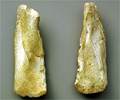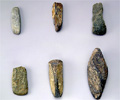In the ruins from prehistoric sites on the islands on the southernmost tip of the Ryukyu archipelago, (the Sakishima. Miyako-jima and Yaeyama Island Groups), there is no apparent influence from Jomon or Yayoi culture. These islands are believed to have received Philippine and Indonesian influences instead. Perhaps the seas lying between Okinawa and Miyako are the boundary of the Japanese culture's southern expansion.
Contemporary with the Jomon Period (Japan)
Earthenware vessels and stone tools have been found from archeological digs in this period. Pottery of the type designated Shimodabaru, as well as thick reddish brown earthenware without decoration are most typical of vessels from this period. The blades of the stone tools were the only portions of the tools that were polished, unlike those discovered in Okinawa and Amami, so it is thought the primary roots of this culture are from Southeast Asia.
Contemporary with the Yayoi to the Heian Periods (Japan)
Many of the sites from this period can be found near the seashore in sandy areas. The large scale of the culture of this time is its characteristic. Centering on the Yaeyama Islands it extended to the Miyako Islands.
Stone and shell axes have been excavated but the absence of pottery indicates a break with the pottery culture during this period. The use of unsuitable giant clam shells for making axes, examples of which have not been found in Amami and Okinawa, is thought to have been brought over from Southeast Asia and other islands from the south. This period extends from 2,500 BC to the10th century AD.


